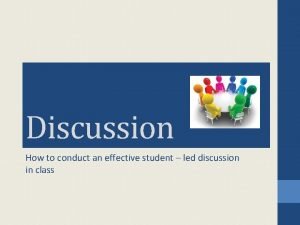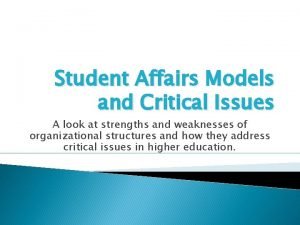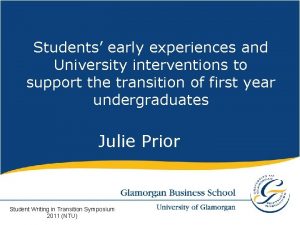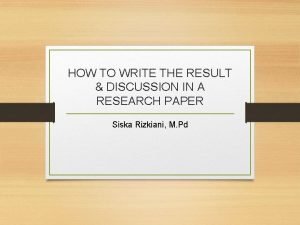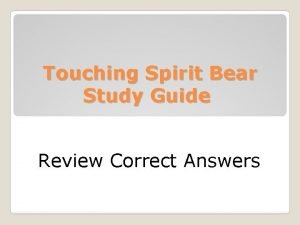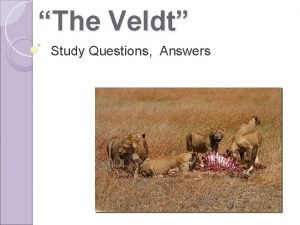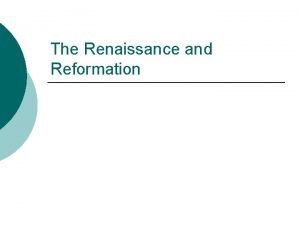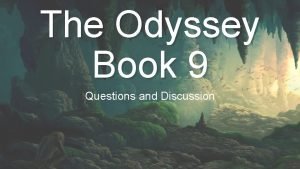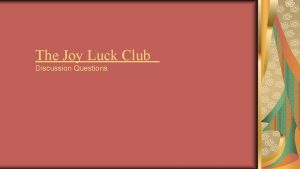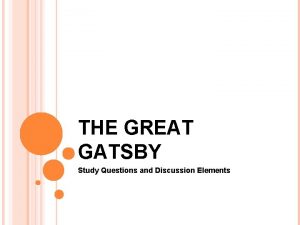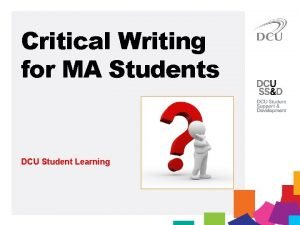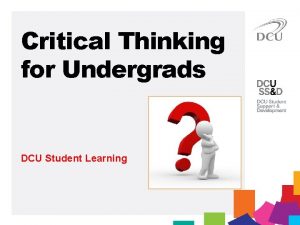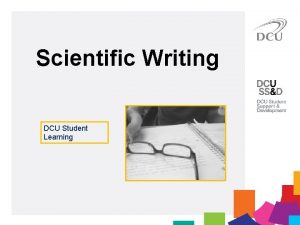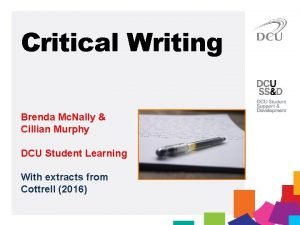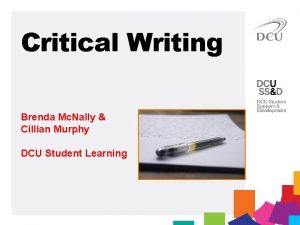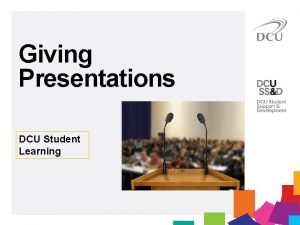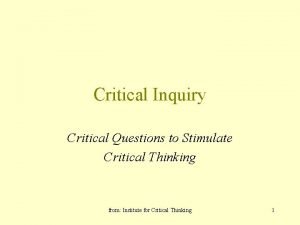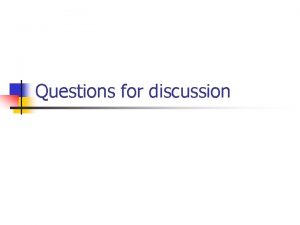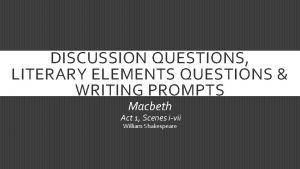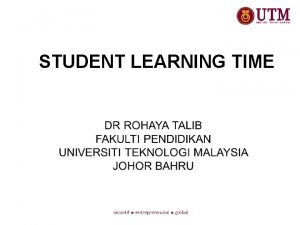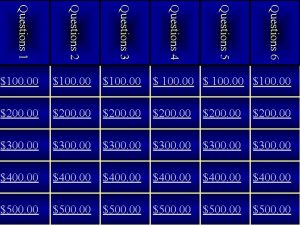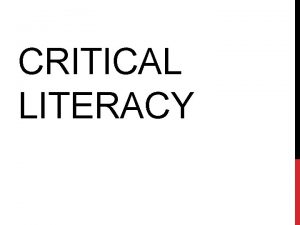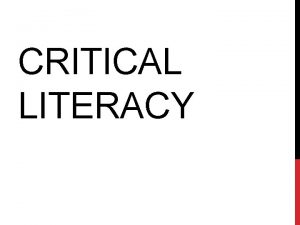Critical Writing DCU Student Learning Discussion What questions


























- Slides: 26

Critical Writing DCU Student Learning

Discussion What questions do you have about critical writing?



Today’s session 1. Definition – critical wheel 2. Critical reading 3. Critical writing

1. Define - What is critical writing? University of Surrey (2016): • A refusal to accept the conclusions of other writers without evaluating the arguments and evidence provided; • A balanced presentation of reasons why the conclusions of other writers may be accepted or treated with caution; • A clear presentation of your own evidence and argument, leading to your conclusion; • A recognition of the limitations in your own evidence, argument, and conclusion.

Critical Process Description Where? When? Who? How? What? Analysis Topic Why? What if? What next? So what? Evaluation Source: Hilsdon (2010)

Description what where who • What is this about? • What is the situation/context? • What is the problem/topic to be explored? • Where does it take place? • Who is involved? • Who might be interested? • When does this occur? when Source: Hilsdon (2010)

Analysis why how what if • • • Why this argument/theory/solution? Why not something else? Why did this occur? Why was that done? How does one factor affect the other? How do the parts fit into the whole? How does it work in theory/practice/context? What if there alternatives? What if there was a problem? What if this factor was added/altered/removed? Source: Hilsdon (2010)

Evaluation so what • So what does this mean? • So what is the implication of this? In what way is it significant? • So what can be learnt from this? • What next in this research field? what next Source: Hilsdon (2010)

2. Critical reading Description 1. What is the author’s position? 2. What is the author’s line of reasoning? 3. What evidence is used and is it strong Analysis evidence? 4. Does the evidence support the Evaluation conclusions? 5. Are the writer’s conclusions meaningful? Adapted from Cottrell (2016)

Example 1 Source: University of Cumbria (2017) Read this critically: does it move from description to analysis to evaluation? Leadership is an essential quality in nursing, as posited by Brown (2005). This is confirmed by the recent requirements of the NHS Plan (DOH, 2002). This Plan has emphasized the importance of introducing the transformational model of leadership. Smith (2001) explains that this is a leadership which involves the use of charisma and interpersonal skills to enable achievement. Jones (2004) argues that the key characteristic of transformational leadership is empowering others to achieve. In my own experience, a leader with transformational qualities can make any team member feel that they have a useful part to play in the organization. This is confirmed by Fea (2001) who argues that transformational leadership increases feelings of self-worth and capability in their team members. Transformational leadership is therefore really important. Follow steps 1 -5 in hand out provided

Example 2 Source: University of Cumbria (2017) Read this critically: does it better analyse the sources referenced? A review of the available literature provides a wealth of examples of authors advocating leadership as an essential quality in nursing. For example, Shackleton (1950) emphasises that nursing needs strong leadership and recommends a strong transactional approach of reward and punishment to get results and promote teamwork. However, more recently, authors have moved towards the concept of charismatic and transformational leadership (Smith, 2001; Jones, 2004). These qualities are also an integral part of the new recommendations in the NHS Plan (DOH 2002). Charisma appears to be a complex phenomenon to define. Davidzhar (1991) suggests that it is an aspect of personality which makes the individual irresistible to others, in terms of their ability to persuade and empower others. However, other authors, such as Romano (1996) and Harvey (2000) highlight the intangible nature of charisma and emphasise the frustrating point that individuals know charisma if they see it, but find it difficult to define. It appears problematic, therefore, to identify exactly how charisma can become an integral part of developing transformational leadership in nursing, if it is a quality which, in itself, is difficult to define. For example, Smith (2001) maintains that transformational leadership uses a combination of charisma and interpersonal skills to enable achievement. However, identifying potential transformational leaders may be a difficulty if the pre-requisite for identifying charismatic individuals is an integral part of this selection process.

Analysing evidence Why is the author choosing to use the evidence they’ve presented? • Is it all presented, or is some missing… • Is there a hidden agenda? • Do they use reliable, disinterested sources • Is there BIAS present? E. g. a drug trial – were all results (positive and negative) reported? Who benefits financially from these results? Does the sponsor of the study benefit? Was there pressure on the researcher to achieve statistical significance for an expensive research project? Has the researcher maybe unintentionally displayed BIAS

Valid criteria Evidence must be evaluated according to valid criteria – previous research in the field or an appropriate theoretical model e. g. a doctor makes a diagnosis of the symptoms (evidence) based on training and knowledge based on medical research (Cottrell, 2016)

Beware statistics What is wrong with this statement? “ 60% of people prefer cats to dogs” Sample size and generalisability? What method of statistical analysis was chosen and why? • T-test • Anova • Regression etc

Valid conclusions Are the conclusions justified by the evidence presented? e. g. (Cottrell 2016) Proposition 1: The karate champion is a woman. (Verifiable fact. ) Proposition 2: My mother is a woman. (Verifiable fact. ) Conclusion: My mother is a woman, therefore she is a karate champion. (False conclusion. )

Exercises Critique the examples on the worksheet provided

3. Critical writing What is an argument? Position Line of reasoning Evidence presented in a sequential logical format to strengthen position Evidence is valid, uses the best available sources and is critiqued Conclusion Recognise limitations in own arguments and conclusions

Progression Your position Strengthened by point 1 Leads to point 2 Connects to point 3 Forms a conclusion that reinforces your position

Critical Writing: Structure Introduction: Present your argument or outline what you aim to achieve in the essay • Where we’re going / why we’re going there Main body: • Description of theory/study/background info • Analysis of evidence • Evaluation of what it all means Conclusion: • Show evidence leads to your argument • Identify weaknesses in your argument • Identify further research questions

Critical Writing: Content Description Analysis Evaluation • Avoid stringing quotes together • Be ‘fair’: assess strengths/weaknesses of other people’s ideas and writing … without prejudice • Check unsubstantiated statements. Have I included sufficient evidence?

Final Example: Meditation essay Research shows that mindfulness may not only be applicable for the prevention of relapse in depression, but also for the treatment of acute depressive symptoms. Hofmann et al. (2010) conducted a meta-analytic review of effect sizes in 39 studies evaluating the efficacy of mindfulness based approaches in treating symptoms of depression. They found that overall mindfulness based therapies for people with depression had a large effect size (0. 95). The study’s authors note that theirs was the first large-scale and scientifically rigorous meta-analysis in this field. Furthermore, the large effect size revealed here was identical to that revealed previously for the efficacy of cognitive behavioural therapy (Butler et al. 2006). This indicates that mindfulness is potentially as effective as the commonly used and broadly scientifically validated cognitive behavioural therapy approach, and that more research is needed to compare the two methods for long-term efficacy, cost benefits and appeal to patients. Source: Murphy (2017)

Discussion 1. Is this piece a good example of academic writing? 2. Can you identify if and where it follows the critical process? Description Analysis Evaluation

Summary Description Where? When? Who? How? What? Analysis Topic Why? What if? What next? So what? Evaluation Source: Hilsdon (2010)

References Cottrell, S. 2016. Critical thinking skills. Available at: http: //www. skills 4 studycampus. com/Student. Home. aspx (Accessed 18 February 2016). Hilsdon, J. 2010. Critical thinking. Available at: https: //www. plymouth. ac. uk/uploads/production/document/path/1/1710/C ritical_Thinking. pdf (Accessed 2 November 2016). Murphy, C. (2013). ‘Mindfulness in educational psychology’, EDUC 41970: Child Assessment and Intervention. University College Dublin. Unpublished essay. University of Cumbria (2017). Critical writing. Available at: https: //my. cumbria. ac. uk/Student-Life/Learning/Skills. Cumbria/FAQs/What-is-critical-writing/#d. en. 59802 (Accessed: 10 October 2017). University of Surrey 2015. What is critical writing. Available at: http: //libweb. surrey. ac. uk/library/skills/writing%20 Skills%20 Leicester/pag e_42. htm (Accessed 2 November 2016).
 Dcu student counselling service
Dcu student counselling service Critical semi critical and non critical instruments
Critical semi critical and non critical instruments Critical semi critical and non critical instruments
Critical semi critical and non critical instruments Dcu writing centre
Dcu writing centre Sls learning login
Sls learning login Anne matthews dcu
Anne matthews dcu Dcu clubs and socs
Dcu clubs and socs Web dcu
Web dcu 15216-dcu-sa
15216-dcu-sa Dcu harvard referencing
Dcu harvard referencing Simple distillation
Simple distillation Cuadro comparativo entre e-learning b-learning y m-learning
Cuadro comparativo entre e-learning b-learning y m-learning Compare non-critical readers with critical readers.
Compare non-critical readers with critical readers. Student-led discussion assignment
Student-led discussion assignment Critical issues in student affairs
Critical issues in student affairs Learning through discussion
Learning through discussion Dialogue examples for students
Dialogue examples for students Writing results and discussion
Writing results and discussion Tuesdays with morrie discussion questions
Tuesdays with morrie discussion questions Who does cole argue with at the circle
Who does cole argue with at the circle The veldt question answers
The veldt question answers Renaissance discussion questions
Renaissance discussion questions Questions about the odyssey
Questions about the odyssey Joy luck club discussion questions
Joy luck club discussion questions The hunger games chapter 3 questions
The hunger games chapter 3 questions Discussion questions for the great gatsby
Discussion questions for the great gatsby Great gatsby location
Great gatsby location













